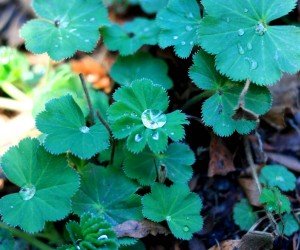This week I began the seriously needed cleanup of my back garden. Clouds of stone dust and noxious fumes from neighbouring construction had kept me from it the past two summers, so I was expecting to spend several days with a rake and pruners. But you know how garden work can be—one thing leads to another, and then to something else. Soon, I was into a full-scale renovation.

First, I took down three self-seeded pagoda dogwoods (Cornus alternifolia), including the mother plant, because they appear to be naturalizing with great efficiency. A young hemlock tree, 20 feet (6 m) tall, which had been overwhelmed by a long-established group of Scots pines, came down, too. But I did make an encouraging discovery: a thriving colony of lady’s mantle (Alchemilla mollis, Zone 4) under dwarf lilac shrubs that had died from drought (those came out, too).
Lady’s mantle is an herbaceous perennial that grows into a generous clump of grey-green leaves with interesting form and texture. The distinctively crimped and folded leaves are densely covered with fine hairs, and are soft to the touch. Their surface tension is sufficient to hold a drop of dew or rain intact, like a ball of mercury. Early herbalists considered this to be the purest of all waters and made quite a lot of effort to collect these silvery liquid drops. Billowing sprays of chartreuse flowers appear in early summer, and make good fillers in vases with roses.
Lady’s mantle stands about 12 inches (30 cm) tall and 18 inches (45 cm) wide, spreading its skirts to make a pretty groundcover. Tatty leaves can be shorn back in midsummer to produce a fresh clump of foliage, and sometimes a second flush of flowers if grown in full sun. It’s often used to edge beds and paths, and makes a lovely companion around the base of shrub roses. The common species is easily found in garden centres, but occasionally cultivars are offered. ‘Auslese’ has lime green flowers, while ‘Thriller’ is more compact. ‘Irish Silk’ and ‘Robusta’ are larger, growing up to 24 inches (60 cm).
I was surprised to find the lady’s mantle so strong and healthy under the heap of dead shrub debris, especially as they haven’t been watered for two years. Not only is it drought hardy, but lady’s mantle also tolerates low light conditions. As it happens, I’ve been looking for a colourful groundcover planting for the slightly dry soil surrounding a dawn redwood tree (Metasequoia glyptostroboides), and lady’s mantle would be just about perfect. I intend to lift the plants and transfer them to under the dawn redwood, where their inclination to seed around will, in time, make a dense groundcover. Their interesting colour and texture will be a good match with the redwood’s delicate needled foliage. I’ve bitten off a big piece of renovation work, but there are rewards.
Other posts by Judith this week:
Posts by Judith last week:








